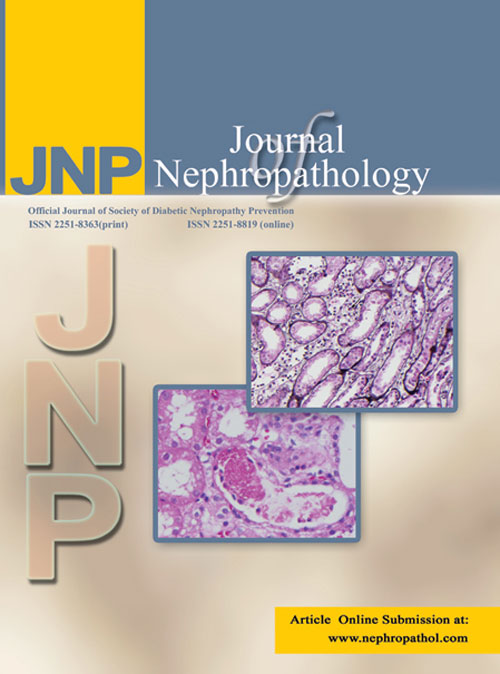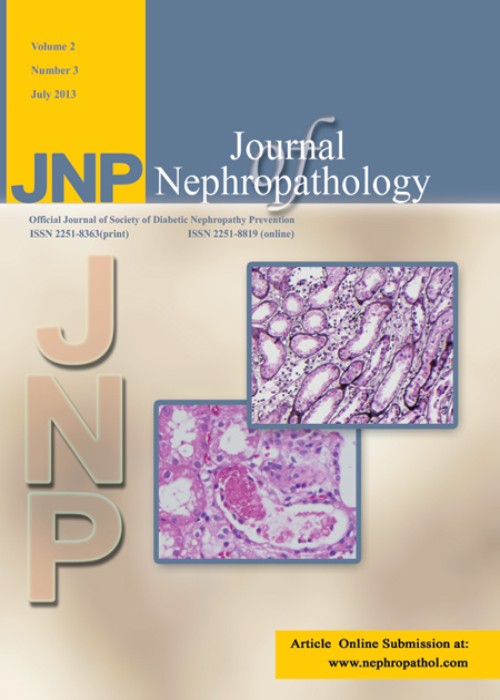فهرست مطالب

Journal of nephropathology
Volume:4 Issue: 4, Oct 2015
- تاریخ انتشار: 1394/07/04
- تعداد عناوین: 6
-
Pages 110-115Context: Preventing acute rejection (AR) after kidney transplantation is of utmost importance because an AR can have a negative impact on long-term allograft survival.Evidence Acquisition: Directory of Open Access Journals (DOAJ), Google Scholar, PubMed, EBSCO, and Web of Science have been searched.ResultsAt the moment this can be done by using rabbit anti-thymocyte globulins (rATGs) as an induction therapy. However, because rATGs are associated with some deleterious side-effects, such as the opportunistic infections cytomegalovirus (CMV) and de novo post-transplant cancer, it is very important they are used optimally, i.e., at minimal doses that avoid many side-effects but still retain optimal treatment efficacy. Recent data show that the risk of CMV infection can be minimized using tacrolimus plus everolimus, and not tacrolimus plus mycophenolic acid, as the maintenance immunosuppression. The use of rATG is particularly valuable in; (a) sensitized patients; (b) in recipients from an expanded-criteria donor, thus enabling the introduction of calcineurin inhibitors at reduced doses; and (c) for patients where steroid avoidance is contemplated. However, we also need to consider that rATG may increase the risk of de novo cancer, even though recent data indicate this is unlikely and that any risk can be reduced by using mammalian target of rapamycin (mTOR) inhibitors instead of mycophenolic acid combined with low-dose calcineurin inhibitors.ConclusionsEven though rATGs do not improve long-term kidney-allograft survival, they may help reduce calcineurin-inhibitor dosage during the early post-transplant period and minimize the risk of AR.Keywords: Kidney transplantation, Anti, thymocyte globulins, Acute rejection, Cytomegalovirus, De novo cancer
-
Pages 116-120BackgroundOccult hepatitis C virus (HCV) infection is defined as the presence of HCV-RNA in liver or peripheral blood mononuclear cells (PBMCs) in the absence of detectable hepatitis C antibody (anti-HCV) or HCV-RNA in the serum. Low concentrations of HCV-RNA may be detected in PBMCs of hemodialysis (HD) patients and this could have a great impact on the management of HD patients.ObjectivesThe aim of this study was to detect the occult HCV infection in Iranian HD patients. Patients andMethodsA total of 70 anti-HCV negative HD patients from three dialysis units in Tehran, Iran were included in this study. In these cases, presence of HCV-RNA in plasma samples was tested by reverse transcriptase-nested polymerase chain reaction (RT-nested PCR). In cases with negative anti-HCV and plasma HCV-RNA, genomic HCV-RNA was checked in PBMC specimens by RT-nested PCR.ResultsSeventy anti-HCV negative HD patients were enrolled in the study. 32.85% and 1.43% of cases had elevated levels of alanine aminotransferase (ALT) and aspartate aminotransferase (AST) respectively. 7.14% of patients had elevated levels of both ALT and AST. HCV-RNA was negative in plasma samples of all anti-HCV negative HD subjects. The genomic HCV-RNA was not detected in any PBMC samples of HD cases with negative anti-HCV and plasma HCV-RNA.ConclusionsOccult HCV infection was not detected in our HD patients despite of elevated levels of liver enzymes in some participants. Further studies involving larger number of HD patients are required to elucidate the rate of occult HCV infection in HD cases.Keywords: Hemodialysis (HD)_Hepatitis C virus (HCV)_HCV_RNA
-
Pages 121-126BackgroundAcute kidney injury (AKI) is a serious complication of cardiac surgery with cardiopulmonary bypass (CPB) which increases postoperative morbidity and mortality.ObjectivesThe study was designed to assess the incidence of AKI and associated risk factors in patients undergoing CPB ancillary to coronary artery bypass grafting (CABG), valve surgery, and combined CABG and valve surgery. Patients andMethodsThis Intuitional Review Board (IRB) approved retrospective study included patients with normal preoperative kidney function (Serum creatinine [sCr] <2.0 mg/dl) who underwent cardiac surgery with CPB between 2012 and 2014. Patients were divided into 2 groups: group I: Patients with cardiac surgery associated AKI (CS-AKI) (postoperative sCr >2 mg/dl with a minimal doubling of baseline sCr) and group II: Patients with a normal postoperative kidney function. Demographic data, body mass index (BMI), co-morbidities, hematologic/biochemical profiles, preoperative ejection fraction (%EF), blood transfusion history, and operative data were compared between the groups. Mean arterial pressure (MAP) was recorded during the operation and in the postoperative period. Δ-MAP was defined as the difference between pre-CPB-MAP and the CPB-MAP.Results241 patients matched the inclusion criteria (CS-AKI incidence = 8.29%). Age, gender, BMI, %EF, and co-morbidities were not predictors of CS-AKI (P > 0.05). High preoperative sCr (P = 0.047), type of procedure (P = 0.04), clamp time (P = 0.003), pump time (P = 0.005) and history of blood transfusion within 14 days postsurgery (P = 0.0004) were associated with risk of CS-AKI. Pre-CPB-MAP, CPB-MAP, Δ-MAP, and ICU-MAP were not significantly different between the 2 groups. Male gender (OR: 5.53; P = 0.048), age>60 (OR: 4.54; P = 0.027) and blood transfusion after surgery (OR: 5.25; P = 0.0054) were independent predictors for postoperative AKI.ConclusionsAge, gender and blood transfusion were independent predictors of cardiac surgery associated AKI.Keywords: Complication, Cardiac surgery, Acute kidney injury, Transfusion, Coronary artery bypass graft
-
Pages 127-133BackgroundChronic kidney disease (CKD) is increasing worldwide and can lead to end-stage renal disease (ESRD).ObjectivesBecause few patients with ESRD in the Republic of Guinea have access to haemodialysis, we retrospectively evaluated the prevalence of CKD, ESRD and access to supportive therapies.Patients andMethods579 CKD patients (304 males; mean age: 44 ± 16 years) were admitted into Conakry nephrology department, the only centre in the Republic of Guinea, between 2009 and 2013. Most patients (63%) resided within Conakry (the capital), 12.5% came from lower Guinea, 11.7% from middle Guinea, 7.9% from upper Guinea and 4.8% from forest Guinea.ResultsReasons for referral were increased serum creatinine (49.5%), hypertension (27%) and diffuse edema (17%). Also, 11% were diabetic, 12.5% were smokers, 17% were HIV-positive, 8.3% were HBV-positive and 15% were HCV-positive. The most frequent symptom at admission was nausea/vomiting (56%). Upon admission, 70.5% of patients already had ESRD. Although no kidney biopsies were performed it was assumed that 34% and 27% of patients had vascular nephropathy and chronic glomerulonephritis, respectively. Of the 385 ESRD patients, only 140 (36.3%) had access to haemodialysis (two sessions/week, 4 hours each). Most patients that received haemodialysis resided within the Conakry region (P < 0.0001). There were significant associations between mortality and (i) terminal stage of CKD (P = 0.0005), (ii) vascular nephropathy (P = 0.002), and (iii) nephropathies of unknown origin (P = 0.0001).ConclusionsA fourfold increase in haemodialysis machines is needed in Conakry, plus four new nephrology/haemodialysis centres within the Republic of Guinea, each holding ≥30 haemodialysis machines.Keywords: Chronic kidney diseases, End, stage renal disease, Hemodialysis
-
Pages 134-140BackgroundEndothelin-1 (ET-1) is a vasoconstrictor peptide that mediates cell proliferation, fibrosis, and inflammation. ET-1 has 2 receptors A and B.ObjectivesThe present study investigated whether administration of ET-1 receptor type A antagonist leads to protect cisplatin (CP) induced nephrotoxicity in ovariectomized-estradiol (Es) treated rats.Materials And MethodsThirty-six ovariectomized Wistar rats were divided into 6 groups. Group 1 received CP (2.5 mg/kg/day) for one week. Groups 2 and 3 received 2 different doses of Es (0.25 and 0.5 mg/kg/week) for 3 weeks, but CP was started in the third week. Group 4 was treated as group 1, but bosentan (BOS, 30 mg/kg/day) was also added. Groups 5 and 6 treated similar to groups 2 and 3 but CP and BOS were added in the third week. At the end of the experiment, blood samples were obtained, and the animals were sacrificed for histopathological investigation of kidney tissue.ResultsThe serum levels of creatinine (Cr) and blood urea nitrogen (BUN) increased by CP; however, BOS significantly elevated the BUN and Cr levels that were increased by CP administration (P < 0.05). Co-treatment of Es, BOS, and CP decreased the serum levels of BUN, Cr, and malondialdehyde (MDA) when compared with the group treated with BOS plus CP (P < 0.05). Such finding was obtained for kidney tissue damage score (KTDS). As expected, Es significantly increased uterus weight (P < 0.05). The groups were not significantly different in terms of serum and kidney nitrite, kidney weight (KW), and bodyweightConclusionsAccording to our findings, BOS could not protect renal functions against CP-induced nephrotoxicity. In contrast, Es alone or accompanied with BOS could protect the kidney against CP-induced nephrotoxicity via reduction of BUN, Cr, and KTDS.Keywords: Cisplatin, Estradiol, Nephrotoxicity, Bosentan, Rat


